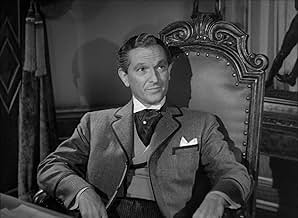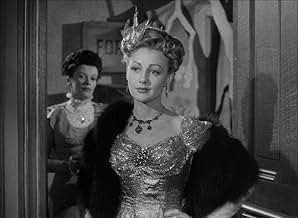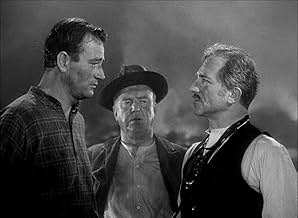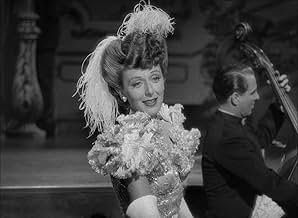IMDb रेटिंग
6.2/10
1.7 हज़ार
आपकी रेटिंग
अपनी भाषा में प्लॉट जोड़ेंA cowboy competes with a gambling tycoon on the Barbary Coast for the hand of a beautiful dance-hall queen.A cowboy competes with a gambling tycoon on the Barbary Coast for the hand of a beautiful dance-hall queen.A cowboy competes with a gambling tycoon on the Barbary Coast for the hand of a beautiful dance-hall queen.
- 2 ऑस्कर के लिए नामांकित
- 2 कुल नामांकन
Abdullah Abbas
- Saloon Patron
- (बिना क्रेडिट के)
Eddie Acuff
- Fireman
- (बिना क्रेडिट के)
Doc Adams
- Saloon Patron
- (बिना क्रेडिट के)
फ़ीचर्ड समीक्षाएं
Who ever came up with the title is to be commended. It suggests a storyline way, way, more interesting than this film turns out to actually be! "Tito" (Joseph Schildkraut) pretty much runs San Francisco and together with his gal "Flaxen" (Ann Dvorak) has quite a easy life - until, that is, cowboy "Duke" (John Wayne) arrives in town and takes a bit of a shine to the lady. He's just a touch too naive though for city life, and soon has to head home - broke - after being fleeced in the casino. Determined to win it all back - and more - he takes lessons in card-playing and soon returns, this time much better prepared to combat the dodgy goings-on at the card table, and to win the heart of the lady. Sadly, aside from a rare few scenes of fisticuff action, this is all rather dreary. The scenario is well trodden, and although Dvorak makes for quite a decent leading lady, the rivalry between the sophisticate crook and his handsome interloper just doesn't ever catch fire. The pace is just too forced, and there is far too much emphasis on the rather uninteresting love triangle element. This film is only really notable for the last fifteen minutes which offers us quite a well created and impressive look at just how the earthquake and subsequent fire devastated the city leaving carnage - and opportunity - in it's wake. Again there is plenty of charm from the star, but it is nowhere near enough to sustain this and though it might have been more impressive on a big screen, on a small one it proves merely to be quite a procedural and, frankly, dull, vehicle for Wayne that promises much but delivers little.
Flame of Barbary Coast finds John Wayne as a visiting cowboy from Montana who makes and loses a fortune in a night and goes home busted. He also finds the love of his life in Ann Dvorak, an entertainer at Joseph Schildkraut's place on the Barbary Coast.
Schildkraut figures that Dvorak is his personal property. But the Dvorak romantic angle is a side issue because Wayne is figuring on not getting mad, but getting even. He's learned a bit about gambling from an oldtimer at the trade in William Frawley.
Of course Wayne and Schildkraut's rivalry is interrupted by the famous earthquake of 1906. As this is Republic Films and not Metro-Goldwyn- Mayer, the special effects are nice, but not near as good as those from MGM. As this was Republic's prestige film of the year, I'm sure it was the best that miserly old Herbert J. Yates could afford.
The most interesting member of the cast is Schildkraut, a scion of the old Spanish aristocracy who's chosen to make his living on the Barbary Coast in the dens of iniquity there. He's as in love with Dvorak as Wayne is, but likes his power and notoriety more.
Yates took some liberties with San Francisco history in this one. The MGM San Francisco did not bother mentioning any of the local political figures of the day, but Flame on Barbary Coast did and got it wrong. Wayne and Schildkraut square off in an election in 1906 that never took place between Mayor Eugene Schmitz and James D. Phelan. Phelan was in fact Schmitz's predecessor in office and Schmitz didn't lose an election. He got himself impeached for setting a standard of corruption that has had some urban historian calling him the worst big city mayor in American history. Now THAT would be an interesting film.
Still the Duke's legion of fans will love him in this one and others will like Joseph Schildkraut.
Schildkraut figures that Dvorak is his personal property. But the Dvorak romantic angle is a side issue because Wayne is figuring on not getting mad, but getting even. He's learned a bit about gambling from an oldtimer at the trade in William Frawley.
Of course Wayne and Schildkraut's rivalry is interrupted by the famous earthquake of 1906. As this is Republic Films and not Metro-Goldwyn- Mayer, the special effects are nice, but not near as good as those from MGM. As this was Republic's prestige film of the year, I'm sure it was the best that miserly old Herbert J. Yates could afford.
The most interesting member of the cast is Schildkraut, a scion of the old Spanish aristocracy who's chosen to make his living on the Barbary Coast in the dens of iniquity there. He's as in love with Dvorak as Wayne is, but likes his power and notoriety more.
Yates took some liberties with San Francisco history in this one. The MGM San Francisco did not bother mentioning any of the local political figures of the day, but Flame on Barbary Coast did and got it wrong. Wayne and Schildkraut square off in an election in 1906 that never took place between Mayor Eugene Schmitz and James D. Phelan. Phelan was in fact Schmitz's predecessor in office and Schmitz didn't lose an election. He got himself impeached for setting a standard of corruption that has had some urban historian calling him the worst big city mayor in American history. Now THAT would be an interesting film.
Still the Duke's legion of fans will love him in this one and others will like Joseph Schildkraut.
Before watching Flame Of Barbary Coast I never read the description on the back cover of the DVD case. It mentions the San Francisco earthquake of 1906. Fortunately I was aware of some of the history of that earthquake, so I was picking up the clues given throughout the movie. All I cared about before watching the movie was that it was a western with John Wayne in it. The movie is a "late" western in that it takes place as the wild west had been tamed and the 20th Century was becoming an entirely different reality.
The plot was okay, but a little thin. A Montana rancher goes to the big city, finds himself played out as a sucker, and returns to conquer the same people who made a fool out of him. Duke Fergus (John Wayne) takes lessons from his professional gambler friend, Wolf Wylie (William Frawley), and ends up beating the professional gamblers in their own casinos. Even for John Wayne this is quite amazing. Added to that is his love interest in Flaxen (Ann Dvorak), known as "the Flame of the Barbary Coast", who apparently has teased virtually every powerful man in town. At the time of the story she is tied to Tito Morrell (Joseph Schildkraut), the most successful and notorious of the gambling house bosses.
I liked the way Joseph Schildkraut played the classy, but devious, casino owner, Tito Morrell. His character hinted at aristocratic old world lineage and his determination to maintain a level of sophistication despite his present reputation. Tito's criminal side is never shown, only implied. John Wayne's character, Duke, never came across as simple. He loved his modest environment at his ranch in Montana, but he had a business sense and some integrity. Ann Dvorak's Flaxen is the character that seems a bit odd. If she has such a reputation for being the unobtainable prize, why do so many still want her? She really does smile her way through everything, too. It would have been really nice if she got one of those famous John Wayne spankings.
Establishing a specific time was done gradually and then deliberately. The house Tito provides for Flaxen is definitely built in an elaborate turn of the century European-influenced style that would not have existed thirty years earlier. Upon arriving in San Francisco there were many electric lights. A bathroom with running water is shown. Eventually a specific date in January of 1906 is mentioned, and later it is mentioned that April of the same year has arrived. Although everyone is moving on foot or in a horse drawn carriage, an automobile appears in one scene. The time placement was subtle in the beginning and made perfectly clear as it became more important to the plot.
I expected the climax of the movie to be the famous San Francisco earthquake. There really were explosions and gas fires from ruptured natural gas lines. Firefighters are shown in the movie running out of water because of broken water mains just as the real firefighters did. It is even mentioned that looters would be shot, as they really were. The catalyst that brought about changes in San Francisco set up the final scenes for the main characters. The true nature of everyone is shown in a final showdown between Duke, Tito, and Flaxen.
I liked Flame Of Barbary Coast. My only complaint is that the movie makes the Barbary Coast seem to be the most important part of San Francisco, and it is the only part of the city that is shown. The sets were elaborate and the actors were good. It cannot be called a gangster movie even though it has crime bosses. Over all it was more of a drama than a western, but it was worth watching.
The plot was okay, but a little thin. A Montana rancher goes to the big city, finds himself played out as a sucker, and returns to conquer the same people who made a fool out of him. Duke Fergus (John Wayne) takes lessons from his professional gambler friend, Wolf Wylie (William Frawley), and ends up beating the professional gamblers in their own casinos. Even for John Wayne this is quite amazing. Added to that is his love interest in Flaxen (Ann Dvorak), known as "the Flame of the Barbary Coast", who apparently has teased virtually every powerful man in town. At the time of the story she is tied to Tito Morrell (Joseph Schildkraut), the most successful and notorious of the gambling house bosses.
I liked the way Joseph Schildkraut played the classy, but devious, casino owner, Tito Morrell. His character hinted at aristocratic old world lineage and his determination to maintain a level of sophistication despite his present reputation. Tito's criminal side is never shown, only implied. John Wayne's character, Duke, never came across as simple. He loved his modest environment at his ranch in Montana, but he had a business sense and some integrity. Ann Dvorak's Flaxen is the character that seems a bit odd. If she has such a reputation for being the unobtainable prize, why do so many still want her? She really does smile her way through everything, too. It would have been really nice if she got one of those famous John Wayne spankings.
Establishing a specific time was done gradually and then deliberately. The house Tito provides for Flaxen is definitely built in an elaborate turn of the century European-influenced style that would not have existed thirty years earlier. Upon arriving in San Francisco there were many electric lights. A bathroom with running water is shown. Eventually a specific date in January of 1906 is mentioned, and later it is mentioned that April of the same year has arrived. Although everyone is moving on foot or in a horse drawn carriage, an automobile appears in one scene. The time placement was subtle in the beginning and made perfectly clear as it became more important to the plot.
I expected the climax of the movie to be the famous San Francisco earthquake. There really were explosions and gas fires from ruptured natural gas lines. Firefighters are shown in the movie running out of water because of broken water mains just as the real firefighters did. It is even mentioned that looters would be shot, as they really were. The catalyst that brought about changes in San Francisco set up the final scenes for the main characters. The true nature of everyone is shown in a final showdown between Duke, Tito, and Flaxen.
I liked Flame Of Barbary Coast. My only complaint is that the movie makes the Barbary Coast seem to be the most important part of San Francisco, and it is the only part of the city that is shown. The sets were elaborate and the actors were good. It cannot be called a gangster movie even though it has crime bosses. Over all it was more of a drama than a western, but it was worth watching.
John Wayne, Duke Fergus, is tagged "King of Luck", after breaking the bank in several casino saloons with the help of Ann Dvorak, as Ann 'Flaxen' Tarry, who says, "You've just been promoted". From Duke to King. How ironic that the man known as The Duke in his lifetime had to be the object of this tongue-in-cheek line. Some would think that The Duke was above being a king. This movie does fit the small screen (of t.v), but maybe it was appropriate for the large screen in 1945 when folks weren't so jaded in their viewings. The real gem of this movie is Joseph Schildkraut, as Boss Tito Morell. How could a shady bad guy be so lovable? We love the under dog. Is there any question that The Duke will walk away with the lady? But Tito is the one who really loves Flaxen, and always holds back from resorting to "fixing" The Duke as his cronies want to do. He may be the evil foil, but you can't help but love this gentleman scoundrel. Loyalty does not pay in the end for our hapless romantic. And talk about obsession: the suitors of Flaxen still hang around even when it seems she will be paralyzed for life after the Great Earthquake (did San Francisco really have electric poles in 1906?!)--they hope the old trooper will return to the stage and awe their hearts, not to mention their libidos! As Flaxen is whisked off in Duke's carriage to Montana, Tito has the best line: "Compliments of the House"....
John Wayne stars as Montana cattle rancher Duke Fergus. He heads to San Francisco to conduct some business and ends up losing his shirt at the Barbary Coast gambling dens, particularly that of Tito Morell (Joseph Schildkraut). Duke vows to master the gambling arts and return to Frisco, not just for revenge, but to win the hand of Morell's showgirl moll Flaxen Tarry (Ann Dvorak). This being turn-of-the-century San Francisco, you just know that the Great Earthquake is going interrupt everyone's plans.
This was another of Republic's "A" pictures, with time spent on costumes, sets, and expensive set-pieces (such as the earthquake sequence, or a large cattle drive). The movie isn't terrible, but the script is bit weak, like in most of these Republic showcases. There's never a good rhythm established to the narrative, and the three main characters never rise above sketches. Dvorak looks good, but if that's her real singing voice heard on the soundtrack, it's pretty awful. Still, if one likes SF earthquake melodrama and adventure, this may be worth checking out. It earned two Oscar nominations, for Best Sound, and Best Score.
This was another of Republic's "A" pictures, with time spent on costumes, sets, and expensive set-pieces (such as the earthquake sequence, or a large cattle drive). The movie isn't terrible, but the script is bit weak, like in most of these Republic showcases. There's never a good rhythm established to the narrative, and the three main characters never rise above sketches. Dvorak looks good, but if that's her real singing voice heard on the soundtrack, it's pretty awful. Still, if one likes SF earthquake melodrama and adventure, this may be worth checking out. It earned two Oscar nominations, for Best Sound, and Best Score.
क्या आपको पता है
- ट्रिवियाWhile in her home, Ann Dvorak introduces herself to John Wayne: "My name is Ann" to which he replies "and I am Duke". Dvorak's character's name is also her real name. Wayne's character's name was also his real-life nickname.
- गूफ़James D. "Jim" Phelan was Mayor of San Francisco from 1897 until 1902, serving 3 terms. He did not run for Mayor after the 1906 earthquake, but served on the Committee of Fifty, set up by the Mayor, Eugene Schmitz.
- भाव
'Smooth' Wylie: Now the first thing to learn about a deck of cards is how to handle 'em. They're a whole lot like women, usually when you pick one up, you wish you hadn't!
- इसके अलावा अन्य वर्जनAlso available in a computer colorized version.
- कनेक्शनEdited into The Green Fog (2017)
- साउंडट्रैकBy the Light of the Silvery Moon
(uncredited)
Music by Gus Edwards
Lyrics by Edward Madden
Performed by Ann Dvorak and the chorus
टॉप पसंद
रेटिंग देने के लिए साइन-इन करें और वैयक्तिकृत सुझावों के लिए वॉचलिस्ट करें
- How long is Flame of Barbary Coast?Alexa द्वारा संचालित
विवरण
बॉक्स ऑफ़िस
- बजट
- $6,00,000(अनुमानित)
- चलने की अवधि
- 1 घं 31 मि(91 min)
- रंग
- पक्ष अनुपात
- 1.37 : 1
इस पेज में योगदान दें
किसी बदलाव का सुझाव दें या अनुपलब्ध कॉन्टेंट जोड़ें
































